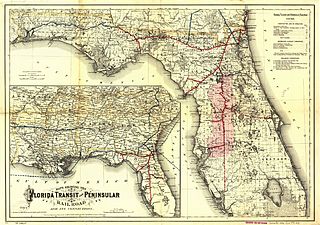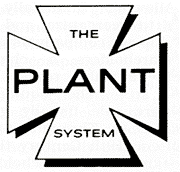
The Florida Central and Peninsular Railroad was the final name of a system of railroads throughout Florida, becoming part of the Seaboard Air Line Railway in 1900. The system, including some of the first railroads in Florida, stretched from Jacksonville west through Tallahassee and south to Tampa. Much of the FC&P network is still in service under the ownership of CSX Transportation.

The Plant System, named after its owner, Henry B. Plant, was a system of railroads and steamboats in the U.S. South, taken over by the Atlantic Coast Line Railroad in 1902. The original line of the system was the Savannah, Florida and Western Railway, running across southern Georgia. The Plant Investment Company was formed in 1882 to lease and buy other railroads and expand the system. Other major lines incorporated into the system include the Savannah and Charleston Railroad and the Brunswick and Western Railroad.
The Brunswick and Western Railroad is a historic railroad in southern Georgia that at its greatest extent ran from Brunswick near the coast to Albany. Segments of the line still exist today. The Brunswick and Florida Railroad ran from Brunswick west to Glenmore, where it would connect with the Atlantic and Gulf Railroad.
The Charleston and Savannah Railway was a 19th-century American railroad serving the coastal states of South Carolina and Georgia and running through part of the South Carolina Lowcountry. Its name varied slightly over time:
The Columbus Southern Railway is a historic railroad that operated in the U.S. state of Georgia. The railroad operated an 88-mile line from Columbus to Albany that opened in 1890.
The Savannah, Americus and Montgomery Railway (SA&M) was a historic railroad located in the U.S. states of Georgia and Alabama. SA&M was built in the 1880s running between Montgomery, Alabama and Lyons, Georgia. It would be completed to Savannah, Georgia in 1896 after being renamed the Georgia and Alabama Railway. The line would notably become part of the Seaboard Air Line Railroad network in 1900.
The Chesterfield and Kershaw Railroad was a railroad that operated in South Carolina in the late 19th and early 20th century.
The Callahan Subdivision is a CSX Transportation railroad subdivision within the Jacksonville Division on the former Seaboard Air Line Railroad. The sub extends northward 20 miles from Baldwin, Florida, where the Jacksonville Terminal Subdivision's S Line and Florida Gulf & Atlantic Railroad meet just north of Baldwin Yard, a classification yard. According to Jacksonville Division Timetable Number 4 published in 2005, the sub runs from milepost SM 0.18 to milepost SM 20.0, where it joins the Nahunta Subdivision, a former Atlantic Coast Line Railroad, in Callahan, Florida. The line serves as a bypass to Jacksonville.
The Jesup Subdivision is a railroad line owned and operated by CSX Transportation in Georgia. The line runs from Jesup, Georgia to Folkston, Georgia for a length of 72.7 miles. It notable passes through Waycross, Georgia, a major CSX freight terminal and CSX operates numerous freight trains over the line. The Jesup Subdivision was once a major route for the Atlantic Coast Line Railroad, one of CSX's predecessors.

The Nahunta Subdivision is a railroad line owned by CSX Transportation in Florida and Georgia. The line runs along CSX's A Line from Ogeechee, Georgia, to Dinsmore, Florida, for a total of 129.2 miles (207.9 km). At its north end it continues south from the Savannah Subdivision and at its south end it continues south as the Jacksonville Terminal Subdivision A-Line. The line is double-tracked from Folkston, Georgia south. All of Amtrak's Florida service also traverses the line.
The Savannah Subdivision is a railroad line owned by CSX Transportation in the U.S. state of Georgia. Through the middle of Savannah, the Savannah Subdivision splits into an east route and a west route. The East Route runs from Savannah, Georgia, to Ogeechee, Georgia, for a total of 15.6 miles (25.1 km). At its north end it continues south from the Charleston Subdivision and the Columbia Subdivision both of the Florence Division and at its south end it continues south as the Nahunta Subdivision. The West Route is located in Savannah, Georgia, and is 9.7 miles (15.6 km) in length. At its north end it branches off of the Savannah Subdivision East Route and at its south end it comes back into the Savannah Subdivision East Route.

The Charleston Subdivision is a railroad territory owned by CSX Transportation in the U.S. states of South Carolina and Georgia. The line from Florence, South Carolina, to Savannah, Georgia, for a total of 195.8 miles. At its north end it continues south from the South End Subdivision and at its south end it continues south as the Savannah Subdivision of the Jacksonville Division.
The Atlantic Coast Line Railroad's Perry Cutoff was a historic rail line in northern Florida running from Monticello southeast to Perry. The line provided a shortcut through the Big Bend of Florida for rail traffic running between the Midwest and the Tampa Bay area by providing a more direct route and a bypass for the busy rail hub in Jacksonville. It was completed in 1928 to reduce travel times for its passenger trains to the west coast, or Gulf Coast, of Florida during the Florida land boom of the 1920s.
The Live Oak, Tampa and Charlotte Harbor Railroad was a historic railroad in Florida chartered by railroad tycoon Henry B. Plant. It was built as an extension of Plant's Live Oak and Rowlands Bluff Railroad. Together, the two lines ran from Live Oak, Florida to Gainesville via High Springs. The lines were completed in 1884.
The Folkston Cutoff is a railroad line in southern Georgia. It runs from Jesup southwest to Folkston, a distance of 54 miles. It was built in 1901 by the Plant System to allow trains from the northeast to Florida to bypass their busy terminal in Waycross.

The CSX A Line forms the backbone of the historic Atlantic Coast Line Railroad Main Line, the backbone of their network in the southeastern United States. The main line runs from Richmond, Virginia to Port Tampa just southwest of Tampa, Florida, a distance of nearly 900 miles. Along its route it passes through Petersburg, Rocky Mount, Florence, Charleston, Savannah, Jacksonville, and Orlando. With the exception of a short 61-mile segment in Greater Orlando, the entire line is owned by CSX Transportation.
The Atlantic Coast Line Railroad's DuPont—Lakeland Line was a historic rail line in southern Georgia and the northern west coast of Florida. On employee timetables, the line was actually divided into the DuPont—High Springs Line and the High Springs—Lakeland Line. The line was primarily used for freight, though some passenger services ran on parts of it in Florida. While parts of the line were built as early as 1863, the full line was not complete until 1913. Parts of the line in Florida are still active today.
The Seaboard Air Line Railroad’s Main Line was the backbone of the Seaboard Air Line Railroad's network in the southeastern United States. The main line ran from Richmond, Virginia to Tampa, Florida, a distance of over 800 miles. Along its route it passed through Petersburg, Raleigh, Columbia, Savannah, Jacksonville, and Ocala, Florida. While some segments of the line have been abandoned as of 2023, most of the line is still in service and is owned by the Seaboard Air Line's successor, CSX Transportation as their S-Line.
The Atlantic Coast Line Railroad's Waycross—Montgomery Line was one of the company's secondary main lines running from Waycross, Georgia west to Montgomery, Alabama, a distance of over 300 miles. It was built in the late 1800s by the Atlantic Coast Line's predecessor companies. The line is still in service today and is now the Thomasville Subdivision and Dothan Subdivision of CSX Transportation, the Atlantic Coast Line's successor company through various mergers.
The Atlantic Coast Line Railroad's Albany—Thomasville Line was a historic railroad line in southern Georgia. Built in 1869 by the company's predecessors, it carried some of the Atlantic Coast Line's passenger trains on their routes from the Midwest to the Southeastern United States. The line is still in service today and is now operated by the Georgia and Florida Railway.







